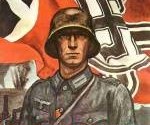|
Since my photographic collection mainly focuses on early to mid war eastern photographs, I found that I had little information
on late war (Post Normandy) headgear in the Heeres. However, I do have a small collection of POW photographs, most of them
showing larger groups of captured soldiers. In studying these photographs, I find a marked difference in the headgear worn
by these men. From a collection of 53 photographs, showing approximately 200 men, there were 123 which I could see their
exact headgear (the rest were either hatless or the photo was too out of focus to make a positive identification.)
Of these 123 subjects, the headgear breakdown is as follows,
102 wore M43 caps
18 wore M42 caps
3 wore M34 caps
As it is nearly impossible to see in pictures if a M43 cap is actually a M42 converted by adding the bill, it was not
added into the equation.
Unfortunately, when examining the photographs, it was nearly impossible to tell what insignia the caps had. Of the aforementioned
photographs, 20 of them had insignia, of which 7 were discernable as 2 piece, and 10 were trapezoids. The other three were
indiscernible.
What do these numbers mean? Why do we see this marked difference between the midwar photographs, in which the m43 is
a relative rarity to these, where the other style caps are nearly nonexistent? There are a few reasons why this occurred.
First of all, after the Normandy invasion, the German manufacturing had to go into overload to supply the new troops being
sent to the field, as well as resupplying those that had worn out, and so there was a massive influx of the M43 style cap
into the theater. Also, it is beneficial to remember that during the last stages of the war, many of the men were no longer
being transferred in from other fronts, instead, the were new recruits, coming directly from the fatherland. These men would
have been freshly supplied with the M43 when deployed.
What does this mean for the Reenactor? Basically, if you are doing a late war impression, especially from the Battle
of the Bulge onward, it would be historically accurate to wear a M43 cap primarily, with perhaps one or two M34 and M42 caps
in the unit as a whole. It also seems that at this point of the war the trapezoid was more popular. However, since the evidence
pool was so low on these subjects, that particular assumption may be unfounded. Further research is planned in this area.
The only time period that is unaccounted for is the 1943-44 period. The number of photographs that depict personnel wearing
headgear from this time (men obviously wearing m43 style tunics, or other indicators.). However, it stands to reason that
the trend would have stayed from earlier areas, albeit with greater numbers of the M42 and M43 caps into the ranks.
|

